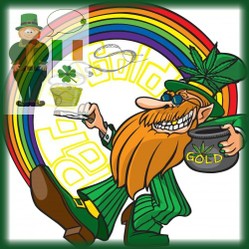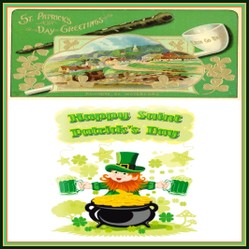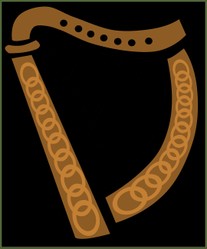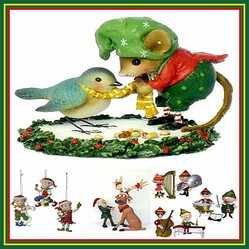According to the Irish fables the leprechaun is an Irish male fairy. He appears like a little, out of place guy who is about two feet tall frequently dressed in a shoemaker outfit. He can be an old man with old ways and a crooked hat dressed in a leather apron rather shabbily.
In accordance to the Irish fairy tales, the cute and funny leprechauns are distant and detached, residing on their own passing their time making and repairing footwear. But the legend of Ireland also states that the leprechauns can be very helpful in spite of being shy. They have hidden treasures which they give to generous and benevolent people. Many of them have a concealed pot of gold which they are guarding and try their best to hide them from pillagers, bandits and thieves.
Image from Amazon.com
© copyright WriterArtist 2015, All rights reserved
















 Harvest Bounty of Fall Fruitson 08/03/2023
Harvest Bounty of Fall Fruitson 08/03/2023
 Is Buddhism older than Hinduism?on 06/13/2023
Is Buddhism older than Hinduism?on 06/13/2023
 Was Tirumala Tirupati Balaji Temple a Buddhist Shrine?on 06/13/2023
Was Tirumala Tirupati Balaji Temple a Buddhist Shrine?on 06/13/2023
 The Great Wave of Kanagawa from Japanese Artist Hokusaion 06/11/2023
The Great Wave of Kanagawa from Japanese Artist Hokusaion 06/11/2023




Do you like this mischievous fairy from Ireland?
Irish folklore is wary of the Sidhe, [fairy folk] for they were traditionally ill-tempered and not always friendly to humans. The Irish traditionally do not disturb the Sidhe's fairy mounds or the hawthorn trees under which the fairy folk live.
But clurichauns are friendly fairies that guard your wine cellar. But tradition has it that they are partial to a tipple!
Sidhe is pronounced shee.
WriterArtist, Thank you for product lines, pretty pictures and practical information.
In particular, I'm drawn to the ornament tree, the top hat and the tree wrap.
It must require a steady gaze to catch a leprechaun. Wouldn't it be important not to blink?
Yes, Pucai are known in Irish folklore. There is the tune, Port na Bpucai [port na bookie.] A port is a term for a harp tune, though this was originally played on the fiddle. The story goes that a shepherd staying for the summer grazing on Inish Vickilane, an island in the Blaskett Isles off Kerry in South West Ireland, heard ethereal music, during the evening, which he took to be fairy music, and he copied it on his fiddle. It is a strange sound. Biologists have identified a possible source as whales calling each other, but he was convinced that he was hearing fairy music. It is a strange, non-human sound, but very beautiful.
Don't forget the Puca ( Pwca , Bucca Pooka ) . The Puca is a very mischievous shape changing spirit. IT seems to cross various Western European lands and brings good or bad luck .
The term also influences Shakespeare's ' midsummer night's dream' using Puck as the mischievous fairy/ imp.
The Western Irish used to believe that the fairies abducted baby boys, so many parents used to dress young baby boys as girls to confuse the fairy abductors. There was also the belief that if you thought the Sidhe were after you, you turned your coat inside out to confuse them.
Yet the Sidhe love music. There is a folk tale that a man was in trouble for offending them, but fortuitously there arrived Turlough O'Carolan, the last of the great harpists of Ireland, who took out his clarsach, the bronze strung Gaelic harp, and began to weave enchanting music. Slowly the Sidhe began to appear and were completely charmed by the power of his melodies. When he had finished they asked him what reward he wanted and he replied that they should spare the man who had offended them. They agreed.
O'Carolan [1670-1738] was a magnificent harpist. One of his most beautiful compositions is Carolan's farewell to music, which he spontaneously composed as he was on his death bed. Having listened to this I can see why people believed that he could enchant even the fairies.
I spent last summer in Galway and they call the fairies Shee-ogs.
The fairy forts are certainly interesting.
Interesting article and comments!:) Fascinating what Frank says about fairy forts.
I misspelled the term, which should be Sidhe. The Galway pronunciation, Shee-og, is different from the pronunciation elsewhere, though the Irish and Scots do speak of some places as Sheeogy, places with the Sidhe atmosphere on them. I suspect that the Galway pronunciation derives from this usage , though og, which means young, can be used as a term of endearment. Sheeogy places are not confined to Gaelic realms, as they are what the English call fey.
I did not say earlier that banshee means fairy woman, for the banshee is always female.
If you are of Galway stock you call fairies Sidheag (pronounced she-og )
My wife's uncle in county Mayo has two fairy forts on his farm. He has never disturbed them, for the Irish were traditionally wary of disrupting the activities of the Side, for the fairies were not considered to be always benevolent beings, and those who interfered with them were thought to suffer bad luck. People avoided the fairy forts at night, when the Sidhe were considered to be at their most active.